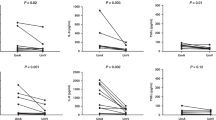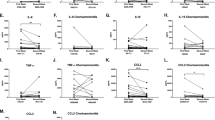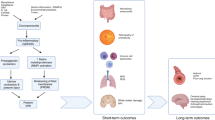Abstract
Chorioamnionitis and funisitis are associated with preterm labor and postnatal morbidity. Activation of endothelium resulting in up-regulation of adhesion molecules seems to be a key mechanism in development of organ damage. We investigated whether chorioamnionitis with or without funisitis in preterm infants induced expression and shedding of adhesion molecules in the umbilical cord and resulted in increased concentrations of E-selectin, intercellular adhesion molecule (ICAM)-1, IL-1β, IL-6, and IL-8 in the cord blood. Data were obtained by using immunohistochemistry and ELISA. Thirty-two preterm infants were divided into three groups according to histology: chorioamnionitis with funisitis, chorioamnionitis without funisitis, and controls without signs of inflammation. ICAM-1 expression on arterial endothelium was higher with funisitis compared with chorioamnionitis alone or with the control group. Similar results for ICAM-1 expression were found in venous endothelium, vascular walls, Wharton's jelly, and amnion epithelium. Endothelial E-selectin and vascular cell adhesion molecule (VCAM)-1 expression was only induced significantly with funisitis. Serum-concentrations of soluble ICAM-1 were higher with funisitis compared with chorioamnionitis alone or control group. Similarly, concentrations of soluble E-selectin, IL-1β, IL-6, and IL-8 were increased exclusively with funisitis. In conclusion, only chorioamnionitis with funisitis was associated with systemic inflammation and endothelial activation with up-regulation and shedding of umbilical cord adhesion molecules. We speculate that this activation of endothelium may not be limited to the umbilical cord but may also involve other organs resulting in neonatal morbidity. This underlines the importance of funisitis as a risk factor for adverse outcome.
Similar content being viewed by others
Log in or create a free account to read this content
Gain free access to this article, as well as selected content from this journal and more on nature.com
or
Abbreviations
- ICAM-1:
-
intercellular adhesion molecule-1
- IQR:
-
interquartile range
- PROM:
-
premature rupture of membranes
- TNF-α:
-
tumor necrosis factor-α
- VCAM-1:
-
vascular cell adhesion molecule-1
References
Goldenberg RL, Andrews WW, Hauth JC 2002 Choriodecidual infection and preterm birth. Nutr Rev 60: 19–S25
Morrison JC 1990 Preterm birth: a puzzle worth solving. Obstet Gynecol 76: S–12S
Copper RL, Goldenberg RL, Creasy RK, DuBard MB, Davis RO, Entman SS, Iams JD, Cliver SP 1993 A multicenter study of preterm birth weight and gestational age-specific neonatal mortality. Am J Obstet Gynecol 168: 8–84
Speer CP 2003 Inflammation and bronchopulmonary dysplasia. Semin Neonatol 8: 9–38
Bracci R, Buonocore G 2003 Chorioamnionitis: a risk factor for fetal and neonatal morbidity. Biol Neonate 83: 5–96
Gomez R, Romero R, Ghezzi F, Yoon BH, Mazor M, Berry SM 1998 The fetal inflammatory response syndrome. Am J Obstet Gynecol 179: 94–202
Toti P, De Felice C 2001 Chorioamnionitis and fetal/neonatal brain injury. Biol Neonate 79: 01–204
Yoon BH, Romero R, Kim CJ, Jun JK, Gomez R, Choi JH, Syn HC 1995 Amniotic fluid interleukin-6: a sensitive test for antenatal diagnosis of acute inflammatory lesions of preterm placenta and prediction of perinatal morbidity. Am J Obstet Gynecol 172: 60–970
Springer TA 1990 Adhesion receptors of the immune system. Nature 346: 25–434
Romero R, Mazor M, Brandt F, Sepulveda W, Avila C, Cotton DB, Dinarello CA 1992 Interleukin-1 alpha and interleukin-1 beta in preterm and term human parturition. Am J Reprod Immunol 27: 17–123
Romero R, Mazor M 1988 Infection and preterm labor. Clin Obstet Gynecol 31: 53–584
Sampson JE, Theve RP, Blatman RN, Shipp TD, Bianchi DW, Ward BE, Jack RM 1997 Fetal origin of amniotic fluid polymorphonuclear leukocytes. Am J Obstet Gynecol 176: 7–81
Pacora P, Chaiworapongsa T, Maymon E, Kim YM, Gomez R, Yoon BH, Ghezzi F, Berry SM, Qureshi F, Jacques SM, Kim JC, Kadar N, Romero R 2002 Funisitis and chorionic vasculitis: the histological counterpart of the fetal inflammatory response syndrome. J Matern Fetal Neonatal Med 11: 8–25
Maudsley RF, Brix GA, Hinton NA, Robertson EM, Bryans AM, Haust MD 1966 Placental inflammation and infection. A prospective bacteriologic and histologic study. Am J Obstet Gynecol 95: 48–659
Naccasha N, Hinson R, Montag A, Ismail M, Bentz L, Mittendorf R 2001 Association between funisitis and elevated interleukin-6 in cord blood. Obstet Gynecol 97: 20–224
Yoon BH, Romero R, Park JS, Kim M, Oh SY, Kim CJ, Jun JK 2000 The relationship among inflammatory lesions of the umbilical cord (funisitis), umbilical cord plasma interleukin 6 concentration, amniotic fluid infection, and neonatal sepsis. Am J Obstet Gynecol 183: 124–1129
Yoon BH, Park CW, Chaiworapongsa T 2003 Intrauterine infection and the development of cerebral palsy. BJOG 10: 24–127
Kim CJ, Yoon BH, Romero R, Moon JB, Kim M, Park SS, Chi JG 2001 Umbilical arteritis and phlebitis mark different stages of the fetal inflammatory response. Am J Obstet Gynecol 185: 96–500
Matsuda T, Nakajima T, Hattori S, Hanatani K, Fukazawa Y, Kobayashi K, Fujimoto S 1997 Necrotizing funisitis: clinical significance and association with chronic lung disease in premature infants. Am J Obstet Gynecol 177: 402–1407
DiSalvo D 1998 The correlation between placental pathology and intraventricular hemorrhage in the preterm infant. The Developmental Epidemiology Network Investigators. Pediatr Res 43: 5–19
Yoon BH, Romero R, Park JS, Kim CJ, Kim SH, Choi JH, Han TR 2000 Fetal exposure to an intra-amniotic inflammation and the development of cerebral palsy at the age of three years. Am J Obstet Gynecol 182: 75–681
Leviton A, Paneth N, Reuss ML, Susser M, Allred EN, Dammann O, Kuban K, Van Marter LJ, Pagano M, Hegyi T, Hiatt M, Sanocka U, Shahrivar F, Abiri M, Disalvo D, Doubilet P, Kairam R, Kazam E, Kirpekar M, Rosenfeld D, Schonfeld S, Share J, Collins M, Genest D, Shen-Schwarz S, et al 1999 Maternal infection, fetal inflammatory response, and brain damage in very low birth weight infants. Developmental Epidemiology Network Investigators. Pediatr Res 46: 66–575
Mittendorf R, Montag AG, MacMillan W, Janeczek S, Pryde PG, Besinger RE, Gianopoulos JG, Roizen N 2003 Components of the systemic fetal inflammatory response syndrome as predictors of impaired neurologic outcomes in children. Am J Obstet Gynecol 188: 1438–1444 discussion 1444–1446
Radi ZA, Kehrli ME Jr, Ackermann MR 2001 Cell adhesion molecules, leukocyte trafficking, and strategies to reduce leukocyte infiltration. J Vet Intern Med 15: 16–529
Phillips ML, Nudelman E, Gaeta FC, Perez M, Singhal AK, Hakomori S, Paulson JC 1990 ELAM-1 mediates cell adhesion by recognition of a carbohydrate ligand, sialyl-Lex. Science 250: 130–1132
Albelda SM, Smith CW, Ward PA 1994 Adhesion molecules and inflammatory injury. FASEB J 8: 04–512
Salafia CM, Weigl C, Silberman L 1989 The prevalence and distribution of acute placental inflammation in uncomplicated term pregnancies. Obstet Gynecol 73: 83–389
Tauscher MK, Berg D, Brockmann M, Seidenspinner S, Speer CP, Groneck P 2003 Association of histologic chorioamnionitis, increased levels of cord blood cytokines, and intracerebral hemorrhage in preterm neonates. Biol Neonate 83: 66–170
Austgulen R, Arntzen KJ, Haereid PE, Aag S, Dollner H 1997 Infections in neonates delivered at term are associated with increased serum levels of ICAM-1 and E-selectin. Acta Paediatr 86: 74–280
Dogan A, MacDonald TT, Spencer J 1993 Ontogeny and induction of adhesion molecule expression in human fetal intestine. Clin Exp Immunol 91: 32–537
Aziz KE, Wakefield D 1996 Modulation of endothelial cell expression of ICAM-1, E-selectin, and VCAM-1 by beta-estradiol, progesterone, and dexamethasone. Cell Immunol 167: 9–85
Chen W, Lee JY, Hsieh WC 2002 Effects of dexamethasone and sex hormones on cytokine-induced cellular adhesion molecule expression in human endothelial cells. Eur J Dermatol 12: 45–448
Vanhee D, Delneste Y, Lassalle P, Gosset P, Joseph M, Tonnel AB 1994 Modulation of endothelial cell adhesion molecule expression in a situation of chronic inflammatory stimulation. Cell Immunol 155: 46–456
Steinborn A, Sohn C, Heger S, Niederhut A, Hildenbrand R, Kaufmann M 1999 Labour-associated expression of intercellular adhesion molecule-1 (ICAM- 1) in placental endothelial cells indicates participation of immunological processes in parturition. Placenta 20: 67–573
Scholz D, Devaux B, Hirche A, Potzsch B, Kropp B, Schaper W, Schaper J 1996 Expression of adhesion molecules is specific and time-dependent in cytokine-stimulated endothelial cells in culture. Cell Tissue Res 284: 15–423
Bevilacqua MP, Stengelin S, Gimbrone MA Jr, Seed B 1989 Endothelial leukocyte adhesion molecule 1: an inducible receptor for neutrophils related to complement regulatory proteins and lectins. Science 243: 160–1165
Craven CM, Ward K 2000 Fetal endothelial cells express vascular cell adhesion molecule in the setting of chorioamnionitis. Am J Reprod Immunol 43: 59–263
Wang X, Feuerstein GZ, Gu JL, Lysko PG, Yue TL 1995 Interleukin-1 beta induces expression of adhesion molecules in human vascular smooth muscle cells and enhances adhesion of leukocytes to smooth muscle cells. Atherosclerosis 115: 9–98
Braun M, Pietsch P, Schror K, Baumann G, Felix SB 1999 Cellular adhesion molecules on vascular smooth muscle cells. Cardiovasc Res 41: 95–401
Marvin KW, Hansen WR, Miller HC, Eykholt RL, Mitchell MD 1999 Amnion-derived cells express intercellular adhesion molecule-1: regulation by cytokines. J Mol Endocrinol 22: 93–205
Hata T, Kawamura T, Inada K, Fujiwaki R, Ariyuki Y, Hata K, Kitao M 1996 Cord blood cytokines and soluble adhesion molecules in vaginal and cesarean delivered neonates. Gynecol Obstet Invest 42: 02–104
Chiu JJ, Chen CN, Lee PL, Yang CT, Chuang HS, Chien S, Usami S 2003 Analysis of the effect of disturbed flow on monocytic adhesion to endothelial cells. J Biomech 36: 883–1895
Shimoya K, Matsuzaki N, Taniguchi T, Jo T, Saji F, Kitajima H, Fujimura M, Nakayama M, Tanizawa O 1992 Interleukin-8 in cord sera: a sensitive and specific marker for the detection of preterm chorioamnionitis. J Infect Dis 165: 57–960
Singh B, Merchant P, Walker CR, Kryworuchko M, Diaz-Mitoma F 1996 Interleukin-6 expression in cord blood of patients with clinical chorioamnionitis. Pediatr Res 39: 76–979
Rogers BB, Alexander JM, Head J, McIntire D, Leveno KJ 2002 Umbilical vein interleukin-6 levels correlate with the severity of placental inflammation and gestational age. Hum Pathol 33: 35–340
Lehrnbecher T, Schrod L, Rutsch P, Roos T, Martius J, von Stockhausen HB 1996 Immunologic parameters in cord blood indicating early-onset sepsis. Biol Neonate 70: 06–212
Smulian JC, Bhandari V, Campbell WA, Rodis JF, Vintzileos AM 1997 Value of umbilical artery and vein levels of interleukin-6 and soluble intracellular adhesion molecule-1 as predictors of neonatal hematologic indices and suspected early sepsis. J Matern Fetal Med 6: 54–259
Boldt J, Wollbruck M, Kuhn D, Linke LC, Hempelmann G 1995 Do plasma levels of circulating soluble adhesion molecules differ between surviving and nonsurviving critically ill patients?. Chest 107: 87–792
Law MM, Cryer HG, Abraham E 1994 Elevated levels of soluble ICAM-1 correlate with the development of multiple organ failure in severely injured trauma patients. J Trauma 37: 100–109 discussion 109–110
Hansen AB, Verder H, Staun-Olsen P 2000 Soluble intercellular adhesion molecule and C-reactive protein as early markers of infection in newborns. J Perinat Med 28: 7–103
Darai E, Poncelet C, Soriano D, Lejeune V, Bringuier AF, Madelenat P, Feldmann G, Scoazec JY 2002 Soluble intercellular adhesion molecule 1 in umbilical cord serum: potential for the diagnosis of neonatal infections. Fetal Diagn Ther 17: 67–172
Ramsay PL, O'Brian Smith E, Hegemier S, Welty SE 1998 Early clinical markers for the development of bronchopulmonary dysplasia: soluble E-Selectin and ICAM-1. Pediatrics 102: 27–932
Ballabh P, Kumari J, Krauss AN, Shin JJ, Jain A, Auld PA, Lesser ML, Cunningham-Rundles S 2003 Soluble e-selectin, soluble L-selectin and soluble icam-1 in bronchopulmonary dysplasia, and changes with dexamethasone. Pediatrics 111: 61–468
Pleines UE, Stover JF, Kossmann T, Trentz O, Morganti-Kossmann MC 1998 Soluble ICAM-1 in CSF coincides with the extent of cerebral damage in patients with severe traumatic brain injury. J Neurotrauma 15: 99–409
Schmidt B, Cao L, Mackensen-Haen S, Kendziorra H, Klingel K, Speer CP 2001 Chorioamnionitis and inflammation of the fetal lung. Am J Obstet Gynecol 185: 73–177
Dammann O, Leviton A 1997 Maternal intrauterine infection, cytokines, and brain damage in the preterm newborn. Pediatr Res 42: 1–8
Blann AD 2000 Endothelial cell activation, injury, damage and dysfunction: separate entities or mutual terms?. Blood Coagul Fibrinolysis 11: 23–630
Speer CP 2001 New insights into the pathogenesis of pulmonary inflammation in preterm infants. Biol Neonate 79: 05–209
Author information
Authors and Affiliations
Corresponding author
Rights and permissions
About this article
Cite this article
D'Alquen, D., Kramer, B., Seidenspinner, S. et al. Activation of Umbilical Cord Endothelial Cells and Fetal Inflammatory Response in Preterm Infants with Chorioamnionitis and Funisitis. Pediatr Res 57, 263–269 (2005). https://doi.org/10.1203/01.PDR.0000148713.48218.86
Received:
Accepted:
Issue date:
DOI: https://doi.org/10.1203/01.PDR.0000148713.48218.86
This article is cited by
-
Magnesium sulfate inhibits inflammation through P2X7 receptors in human umbilical vein endothelial cells
Pediatric Research (2020)
-
Umbilical cord gene expression reveals the molecular architecture of the fetal inflammatory response in extremely preterm newborns
Pediatric Research (2016)
-
Pulmonary inflammation and bronchopulmonary dysplasia
Journal of Perinatology (2006)



